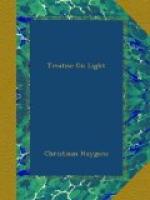Now if about the centres A, B, one describes the circles Dk, El, which represent the spreading of the waves which originate from these two points, and if one draws the straight line Kl which touches these two circles, it is easy to see that this same line will be the common tangent to all the other circles drawn about the centres F, H, etc.; and that all the points of contact will fall within that part of this line which is comprised between the perpendiculars AK, BL. Then it will be the line Kl which will terminate the movement of the particular waves originating from the points of the wave ab; and this movement will be stronger between the points Kl, than anywhere else at the same instant, since an infinitude of circumferences concur to form this straight line; and consequently Kl will be the propagation of the portion of wave ab, as has been said in explaining reflexion and ordinary refraction. Now it appears that AK and BL dip down toward the side where the air is less easy to penetrate: for AK being longer than BL, and parallel to it, it follows that the lines ab and Kl, being prolonged, would meet at the side L. But the angle K is a right angle: hence KAB is necessarily acute, and consequently less than dab. If one investigates in the same way the progression of the portion of the wave Kl, one will find that after a further time it has arrived at mn in such a manner that the perpendiculars km, LN, dip down even more than do AK, BL. And this suffices to show that the ray will continue along the curved line which intersects all the waves at right angles, as has been said.
CHAPTER V
ON THE STRANGE REFRACTION OF ICELAND CRYSTAL
1.
There is brought from Iceland, which is an Island in the North Sea, in the latitude of 66 degrees, a kind of Crystal or transparent stone, very remarkable for its figure and other qualities, but above all for its strange refractions. The causes of this have seemed to me to be worthy of being carefully investigated, the more so because amongst transparent bodies this one alone does not follow the ordinary rules with respect to rays of light. I have even been under some necessity to make this research, because the refractions of this Crystal seemed to overturn our preceding explanation of regular refraction; which explanation, on the contrary, they strongly confirm,




